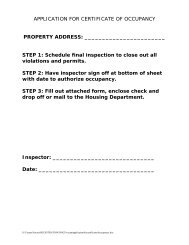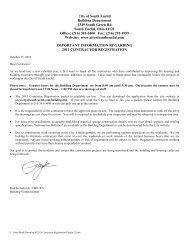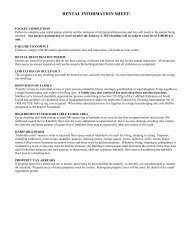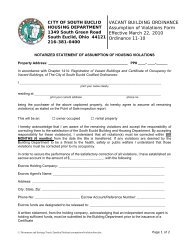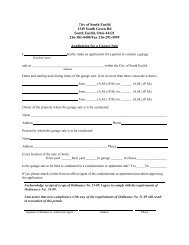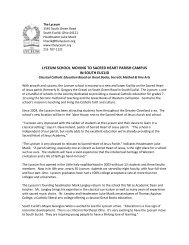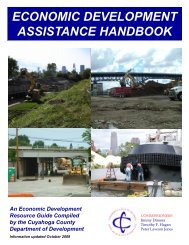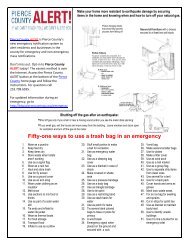SOUTH EUCLID FIRE DEPARTMENT - City of South Euclid
SOUTH EUCLID FIRE DEPARTMENT - City of South Euclid
SOUTH EUCLID FIRE DEPARTMENT - City of South Euclid
You also want an ePaper? Increase the reach of your titles
YUMPU automatically turns print PDFs into web optimized ePapers that Google loves.
<strong>SOUTH</strong> <strong>EUCLID</strong> <strong>FIRE</strong> <strong>DEPARTMENT</strong> – 2011 ANNUAL REPORT<br />
Emergency Medical Service<br />
“What Does a Paramedic Do?”<br />
Paramedics who work for the <strong>South</strong> <strong>Euclid</strong> Fire Department are Firefighter/Paramedics as are<br />
most <strong>of</strong> the paramedics in our surrounding communities. Paramedics are the most highly<br />
trained emergency medical responders. SEFD firefighters who are not trained as paramedics are<br />
trained as Emergency Medical Technicians. The department is mostly (90%) composed <strong>of</strong><br />
paramedics. A paramedic trained today will spend about 1,300 hours training. Paramedics are<br />
trained to bring some very important aspects <strong>of</strong> emergency care right to the victim and start<br />
care as soon as possible.<br />
Our paramedics respond to a wide variety <strong>of</strong> medical emergencies. From motor vehicle crashes,<br />
to heart attacks, strokes, trauma, falls, childbirth, gunshots and other illnesses, the team <strong>of</strong><br />
paramedics initiates lifesaving care. Once on the scene the team will assess the patient, obtain<br />
a medical history and start care. The care will vary on each medical emergency and the<br />
paramedic must be ready for almost anything. Much <strong>of</strong> the care the team <strong>of</strong> paramedics initiate<br />
is the same care they would receive in the emergency room. The paramedics work under the<br />
guidance <strong>of</strong> a medical director and emergency medical protocols. Advanced care includes:<br />
<br />
<br />
<br />
<br />
<br />
Electrocardiogram, <strong>of</strong>ten called an EKG. We use a 12 lead EKG which gives a more<br />
thorough view <strong>of</strong> the heart. The paramedics are trained to review the EKG, which will<br />
serve as a guide to treatment <strong>of</strong> the patient. The EKG’s are transmitted to the<br />
emergency room. This enables the cath lab at hospitals to be ready and waiting for the<br />
patient who needs an emergency heart catheterization.<br />
Administer medications. Medications can be administered several ways. The more<br />
common and effective is through intravenous lines (IV) or interosseous (IO) lines. The<br />
paramedics are able to administer over forty different medications. For each they must<br />
know all the indications, doses, side effects and routes <strong>of</strong> administration.<br />
Insert breathing tubes. The paramedic can insert one <strong>of</strong> several different types <strong>of</strong><br />
breathing tube for the patient who is not, or barely, breathing. The team then assists<br />
the breathing for the patient. The team can monitor the oxygen and carbon dioxide<br />
saturation levels. Some patients who are really struggling benefit greatly from CPAP a<br />
device that helps with their breathing.<br />
Perform a variety <strong>of</strong> critical lifesaving procedures such as defibrillating, inserting a chest<br />
tube, performing a surgical airway, decompressing a collapsed lung and CPR.<br />
Conduct an assessment <strong>of</strong> the patient’s condition to be reported to the emergency<br />
room. This allows for appropriate personnel to be at the ready in the ER.<br />
17



